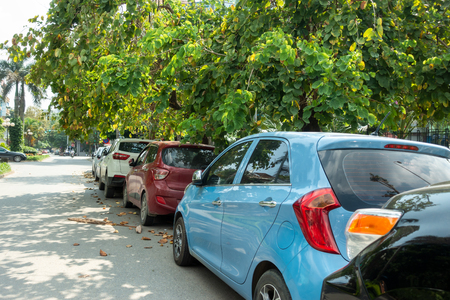Overview of Sedans and SUVs in the Indian Context
In India, the automotive landscape is distinctly shaped by both sedans and SUVs, each catering to different segments of the population. Sedans have long been a favourite among urban professionals and nuclear families, owing to their sleek design, fuel efficiency, and comfort for city commuting. Models such as the Maruti Suzuki Dzire and Honda City are commonly seen on Indian roads, especially in metro cities like Mumbai, Delhi, and Bengaluru. In contrast, SUVs have gained remarkable traction not only among affluent city dwellers but also in tier 2 cities and rural areas. Their robust build, higher ground clearance, and spacious interiors make them ideal for navigating diverse terrains—ranging from well-paved city roads to rugged rural pathways. Popular choices include the Mahindra Scorpio, Tata Harrier, and Hyundai Creta. While sedans are typically preferred for daily office commutes and family outings within urban environments, SUVs are often chosen by larger families or those who frequently travel between cities and villages or require a vehicle capable of handling challenging road conditions. This clear divide in preference highlights the functional roles these vehicles play in Indian society, with ownership patterns reflecting not just lifestyle aspirations but also practical requirements shaped by local infrastructure.
2. Maintenance Costs: Sedans versus SUVs
When evaluating the maintenance costs of sedans and SUVs in Indian cities and villages, several factors come into play, including the availability of spare parts, service charges at authorized workshops or local garages, and the influence of local road and weather conditions. Below is a comparative analysis that highlights the key differences:
Parts Availability & Affordability
In metro cities like Mumbai, Delhi, or Bengaluru, both sedan and SUV spare parts are generally accessible due to a strong dealer network. However, in smaller towns and villages, sedan parts are often easier to find and more affordable, especially for popular brands like Maruti Suzuki or Hyundai. On the other hand, SUVs—particularly imported or premium models—may face delays in part replacement and higher costs.
| Aspect | Sedan (City) | Sedan (Village) | SUV (City) | SUV (Village) |
|---|---|---|---|---|
| Parts Availability | High | Moderate to High | High | Low to Moderate |
| Parts Cost | Lower | Lower | Higher | Highest |
Service Charges & Labour Costs
Authorised service centres in Indian metros usually charge more for both vehicle types compared to local garages in rural areas. However, SUVs generally incur higher service charges because of their complex mechanics and larger size. In smaller towns and villages, while labour may be cheaper, expertise in handling advanced SUV systems can be limited, potentially increasing long-term costs due to improper servicing.
| Service Type | Sedan (Average Cost) | SUV (Average Cost) |
|---|---|---|
| Oil Change & Basic Service (City) | ₹1,500–₹2,500 | ₹2,500–₹4,000 |
| Oil Change & Basic Service (Village) | ₹1,000–₹1,800 | ₹2,000–₹3,500* |
*SUV costs may rise if specialised tools or imported spares are needed.
Impact of Local Road & Weather Conditions
The rough terrain and variable weather in Indian villages accelerate wear and tear on vehicles. While SUVs are built to handle tougher conditions and thus may last longer without major issues, their maintenance—especially suspension components and tyres—is typically more expensive than that of sedans. Conversely, sedans may suffer quicker damage but cost less to repair per incident.
Key Takeaways for Indian Owners
- If you live in a city with well-developed infrastructure and easy access to service centres, the maintenance gap between sedans and SUVs is primarily a matter of initial purchase cost and fuel efficiency.
- In villages or tier-2/tier-3 cities where service options are fewer and roads are rougher, sedans offer lower running costs but may require more frequent attention. SUVs provide better durability but at a premium maintenance price.
- The choice should factor in not just annual expenses but also the convenience of finding reliable spares and skilled mechanics locally.

3. Impact of Terrain: City Roads vs Village Roads
India’s vast geography brings a striking contrast between urban and rural road conditions, which plays a crucial role in determining the maintenance requirements for sedans and SUVs. In metropolitan cities like Mumbai, Delhi, or Bengaluru, roads are predominantly paved but often congested, featuring frequent stop-and-go traffic, speed breakers, and potholes due to heavy usage and monsoon damage. In contrast, village roads can range from basic tarmac to gravel paths or even unpaved stretches, especially during the rainy season.
Wear and Tear on Sedans
Sedans are generally designed for smoother, well-maintained surfaces. In city environments, their lower ground clearance is suitable for tarmac but may result in underbody scraping on poorly maintained or flooded roads. Continuous braking in heavy traffic increases brake pad wear, while potholes and bumps accelerate suspension issues. When sedans are driven on rural or uneven village roads, the risk of tyre damage, wheel misalignment, and premature suspension wear rises significantly.
SUV Performance on Mixed Terrains
SUVs offer higher ground clearance and robust suspension setups tailored for challenging terrains. On city roads, SUVs handle potholes and speed breakers with ease but may suffer from increased body roll and slightly higher tyre wear due to their weight. In villages or semi-urban areas where road quality varies widely, SUVs demonstrate superior reliability by navigating rough patches, mud tracks, or waterlogged sections more efficiently than sedans. However, frequent exposure to dust and debris can necessitate more regular air filter changes and underbody inspections.
Servicing Frequency & Reliability Factors
The frequency of servicing depends heavily on terrain: sedans running exclusively on urban roads might need regular alignment checks and periodic suspension work, while those frequently venturing into villages require closer monitoring of tyres and undercarriage components. SUVs used in rural environments demand routine checks for drivetrain components and protective skid plates but generally prove more reliable over time due to their rugged construction.
Key Takeaway for Indian Car Owners
Ultimately, the choice between sedan and SUV should consider local road realities. Urban dwellers might prefer sedans for comfort and efficiency if daily routes are well-paved; however, those living in or regularly travelling to villages will benefit from an SUV’s durability and all-terrain readiness—although this comes with its own set of maintenance challenges specific to India’s diverse landscapes.
4. Service Network and Spare Parts Availability
One of the most crucial factors impacting car maintenance in India is the accessibility of authorised service centres and the availability of genuine spare parts. This aspect varies considerably between sedans and SUVs, especially when comparing urban cities with rural villages.
Urban India: Wide Service Network
Cities like Mumbai, Delhi, Bengaluru, and Chennai feature a dense network of authorised service centres for both sedans and SUVs. Popular sedan brands (Maruti Suzuki, Hyundai, Honda) and leading SUV manufacturers (Mahindra, Tata, Toyota) have well-established support infrastructure. Urban consumers benefit from:
- Quick access to multiple service outlets
- Shorter waiting times for appointments
- Faster sourcing of original spare parts
- Availability of trained technicians familiar with advanced technologies
Rural India: Limited Reach and Delays
In contrast, villages and tier-3 towns face challenges in accessing quality maintenance services. While Maruti Suzuki and Mahindra have an extensive rural network due to their market dominance, other brands may not be as well-represented. The situation is further complicated for premium sedans and imported SUVs, where:
- Authorised service centres are often located far from rural areas
- Sourcing genuine parts may involve significant delays or higher transportation costs
- Many owners depend on local mechanics who might use non-genuine spares
Comparison Table: Service Accessibility & Spare Parts Availability
| Sedans (Urban) | SUVs (Urban) | Sedans (Rural) | SUVs (Rural) | |
|---|---|---|---|---|
| Service Centre Proximity | High (within 5-10 km) | High (within 5-10 km) | Moderate to Low (20+ km) | Low (often 30+ km) |
| Spares Availability | Readily available | Readily available for popular models | Limited; mostly for common models | Challenging; especially for imported models |
| Technician Expertise | Good; trained staff easily found | Good; OEM-trained staff present | Adequate; generic skills predominant | Adequate to Low; advanced tech less familiar |
| Turnaround Time for Repairs | Fast (1-2 days) | Fast to moderate (1-3 days) | Slow (up to a week or more) | Slow; can extend beyond a week for rare spares |
Cultural Insights and Indian Contextual Factors
The preference for certain brands in rural areas is often dictated by service reach rather than just product features. For example, Mahindra’s Bolero enjoys immense popularity in villages because of its robust service presence and easy access to spares. In urban areas, consumers are more likely to opt for feature-rich sedans or SUVs from global brands due to better after-sales support.
Overall, anyone choosing between a sedan or an SUV should carefully consider the local availability of service networks and spare parts – a factor that can significantly impact long-term ownership experience in both Indian cities and villages.
5. Practical Challenges and User Experiences
Real-World Maintenance Stories from Indian Cities
Car owners in Indian metros like Mumbai, Delhi, and Bangalore often share how cramped parking spaces and congested traffic directly affect their maintenance schedules. For sedan users, the lower ground clearance is a recurring headache—scraping speed breakers or potholes can lead to frequent underbody repairs. Mr. Ramesh from Pune recounts that his compact sedan’s oil sump was damaged twice within a year due to unexpected road bumps, resulting in costly garage visits. On the other hand, urban SUV owners appreciate higher ground clearance and robust suspension systems but highlight increased expenses for tyre replacements and higher service charges. Ms. Priya from Chennai mentions that while her SUV handles monsoon waterlogging better, she faces longer wait times at authorised service centres as SUVs have surged in popularity.
User Experiences from Villages and Small Towns
In rural India, practical challenges are shaped by less developed infrastructure. Sedan owners frequently face difficulties with muddy or unpaved roads; their vehicles get stuck more easily, leading to clutch plate issues and premature wear of brake pads. Mr. Singh from a Punjab village notes that sourcing spare parts for sedans can take days, as most local mechanics are more familiar with rugged SUVs or MUVs common in agricultural regions. Conversely, SUV users enjoy easier navigation across kutcha roads and fields but often encounter high fuel costs—a significant concern where petrol pumps may be far apart. Rural car owners also emphasise the importance of vehicle reliability over luxury features, influencing a preference for simple mechanical systems found in older SUV models.
Cultural Preferences and Daily Realities
Maintenance decisions are also deeply influenced by cultural habits and family needs. In joint families prevalent in both cities and villages, larger SUVs are preferred for their seating capacity and perceived status symbol. However, some urban families opt for sedans due to ease of driving in tight city lanes and lower routine maintenance costs. Another common anecdote is that of festival seasons: many owners delay scheduled servicing until after major holidays like Diwali or Pongal due to travel plans, leading to rushed appointments and sometimes overlooked repairs.
Summary of Common Challenges
Whether living in bustling cities or remote villages, Indian car owners navigate unique maintenance challenges based on terrain, infrastructure, and cultural preferences. Key issues include underbody damage for sedans in cities, limited access to spares for both vehicle types in villages, higher running costs for SUVs, and the impact of seasonal festivities on service routines. These user experiences highlight why choosing between a sedan or SUV goes beyond just initial price—it’s about matching your vehicle to your daily environment and lifestyle.
6. Tips for Indian Car Owners: Maximising Longevity
Regular Checks Suited for Indian Conditions
Whether you drive a sedan through Mumbai’s congested roads or an SUV on rural tracks in Uttar Pradesh, routine checks are crucial. Inspect tyres weekly, as potholes and uneven surfaces are common in both cities and villages. For sedans, pay extra attention to ground clearance-related damages; for SUVs, check suspension and underbody for mud or debris buildup after monsoon drives.
Preventive Maintenance: Sedans vs SUVs
Sedan-Specific Advice
Schedule engine oil changes every 8,000–10,000 km due to stop-and-go traffic in urban areas. Keep a close watch on brake pads and coolant levels—frequent braking in Indian cities accelerates wear. Clean AC filters more often if you park near dusty markets or construction sites.
SUV-Specific Advice
If you use your SUV for village commutes or hill station trips, inspect four-wheel-drive systems and lubricate joints regularly. After off-road or muddy journeys, wash the chassis to prevent rust. Check air filter clogging, especially during harvest seasons or in dusty environments.
Best Practices Across India
- Maintain Service Records: Whether in Delhi or a remote town, keep digital or physical service logs for warranty claims and resale value.
- Battery Care: Extreme temperatures in Rajasthan or high humidity in Kerala can reduce battery life—test voltage every six months.
- Fuel Quality: Fill up at trusted petrol pumps to avoid contaminated fuel, which is a common issue affecting both sedans and SUVs in smaller towns.
Action Steps for All Owners
- Follow manufacturer-recommended service intervals but shorten them if you frequently drive on rough roads.
- Invest in good quality floor mats and seat covers to protect interiors from dust and moisture prevalent across India.
- Use anti-rust coating if your vehicle is exposed to coastal weather or frequent monsoons.
By adopting these tailored maintenance strategies, Indian sedan and SUV owners can ensure their vehicles deliver reliable performance—whether navigating the chaos of city streets or tackling challenging rural terrains.

